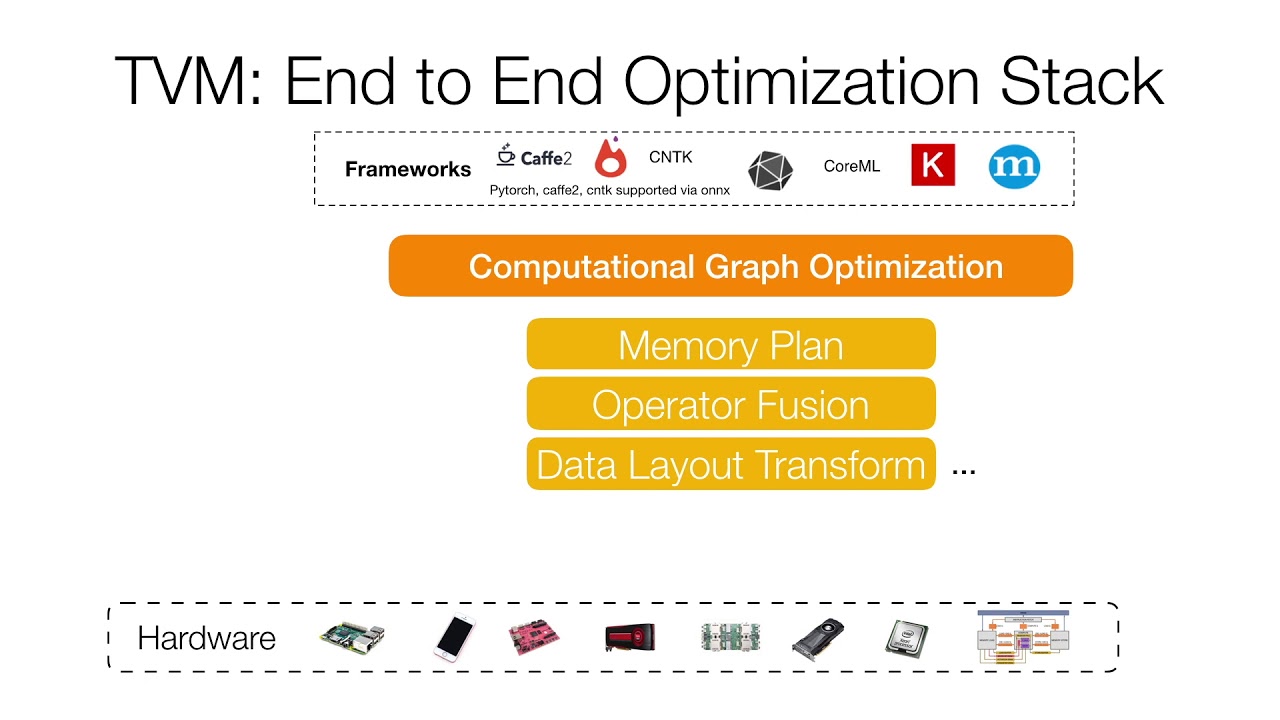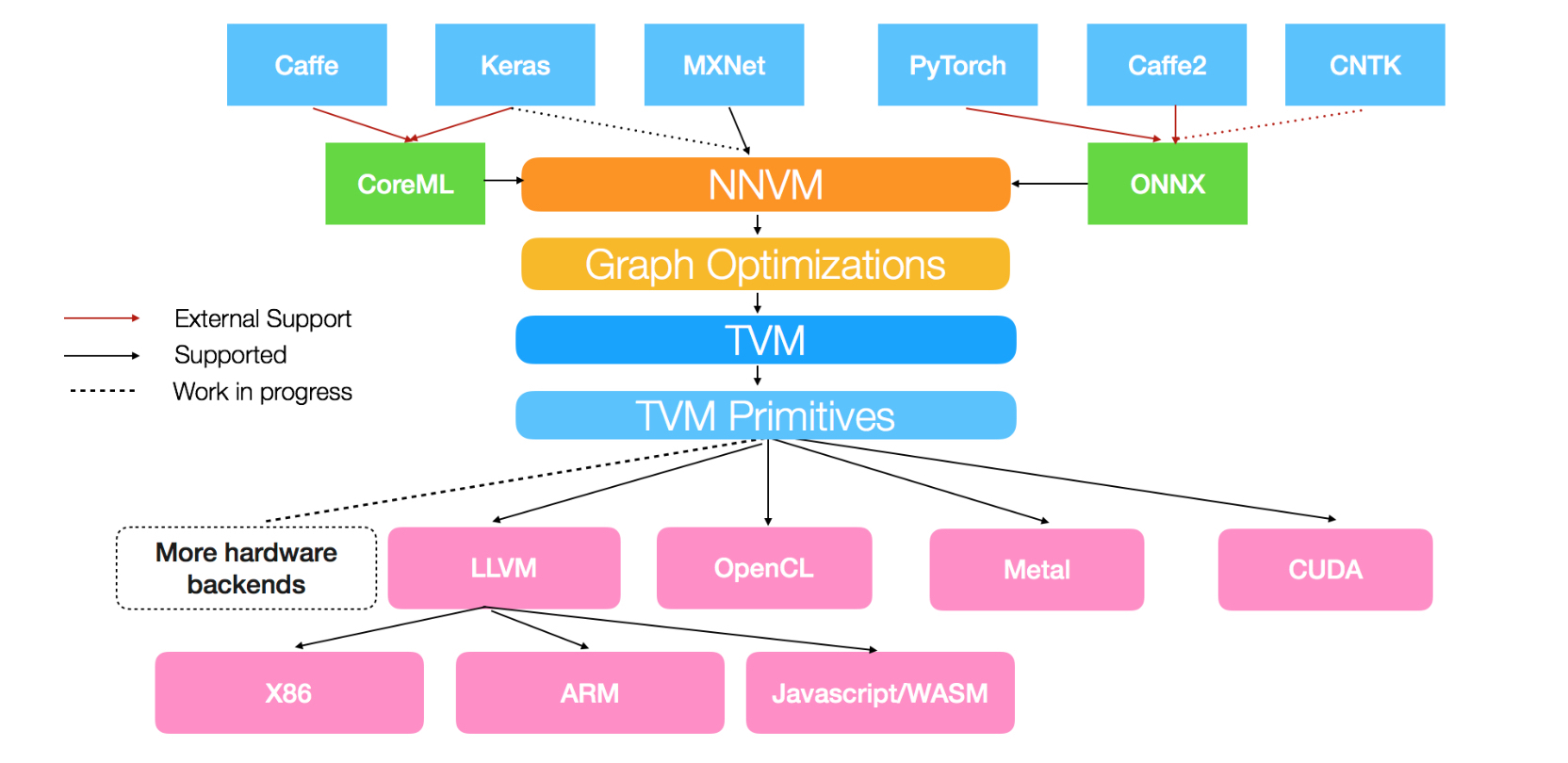TVM 是什么?A compiler stack,graph level / operator level optimization,目的是(不同框架的)深度学习模型在不同硬件平台上提高 performance (我要更快!)
TVM, a compiler that takes a high-level specification of a deep learning program from existing frameworks and generates low-level optimized code for a diverse set of hardware back-ends.
compiler比较好理解。C编译器将C代码转换为汇编,再进一步处理成CPU可以理解的机器码。TVM的compiler是指将不同前端深度学习框架训练的模型,转换为统一的中间语言表示。stack我的理解是,TVM还提供了后续处理方法,对IR进行优化(graph / operator level),并转换为目标硬件上的代码逻辑(可能会进行benchmark,反复进行上述优化),从而实现了端到端的深度学习模型部署。
我刚刚接触TVM,这篇主要介绍了如何编译TVM,以及如何使用TVM加载mxnet模型,进行前向计算。Hello TVM!

背景介绍
随着深度学习逐渐从研究所的“伊甸园”迅速在工业界的铺开,摆在大家面前的问题是如何将深度学习模型部署到目标硬件平台上,能够多快好省地完成前向计算,从而提供更好的用户体验,同时为老板省钱,还能减少碳排放来造福子孙。
和单纯做研究相比,在工业界我们主要遇到了两个问题:
- 深度学习框架实在是太$^{\text{TM}}$多了。caffe / mxnet / tensorflow / pytorch训练出来的模型都彼此有不同的分发格式。如果你和我一样,做过不同框架的TensorRT的部署,我想你会懂的。。。
- GPU实在是太$^{\text{TM}}$贵了。深度学习春风吹满地,老黄股票真争气。另一方面,一些嵌入式平台没有使用GPU的条件。同时一些人也开始在做FPGA/ASIC的深度学习加速卡。如何将深度学习模型部署适配到多样的硬件平台上?
为了解决第一个问题,TVM内部实现了自己的IR,可以将上面这些主流深度学习框架的模型转换为统一的内部表示,以便后续处理。若想要详细了解,可以看下NNVM这篇博客:NNVM Compiler: Open Compiler for AI Frameworks。这张图应该能够说明NNVM在TVM中起到的作用。

为了解决第二个问题,TVM内部有多重机制来做优化。其中一个特点是,使用机器学习(结合专家知识)的方法,通过在目标硬件上跑大量trial,来获得该硬件上相关运算(例如卷积)的最优实现。这使得TVM能够做到快速为新型硬件或新的op做优化。我们知道,在GPU上我们站在Nvidia内部专家的肩膀上,使用CUDA / CUDNN / CUBLAS编程。但相比于Conv / Pooling等Nvidia已经优化的很好了的op,我们自己写的op很可能效率不高。或者在新的硬件上,没有类似CUDA的生态,如何对网络进行调优?TVM这种基于机器学习的方法给出了一个可行的方案。我们只需给定参数的搜索空间(少量的人类专家知识),就可以将剩下的工作交给TVM。如果对此感兴趣,可以阅读TVM中关于AutoTuner的介绍和tutorial:Auto-tuning a convolutional network for ARM CPU。
编译
我的环境为Debian 8,CUDA 9。
准备代码
1 | git clone https://github.com/dmlc/tvm.git |
config文件
1 | cd tvm |
编辑config文件,打开CUDA / BLAS / cuBLAS / CUDNN的开关。注意下LLVM的开关。LLVM可以从这个页面LLVM Download下载,我之前就已经下载好,版本为7.0。如果你像我一样是Debian8,可以使用for Ubuntu14.04的那个版本。由于是已经编译好的二进制包,下载之后解压即可。
找到这一行,改成1
set(USE_LLVM /path/to/llvm/bin/llvm-config)
编译
这里有个坑,因为我们使用了LLVM,最好使用LLVM中的clang。否则可能导致tvm生成的代码无法二次导入。见这个讨论帖:_cc.create_shared error while run tune_simple_template。
1 | export LLVM=/path/to/llvm |
python包安装
1 | cd /path/to/tvm |
demo
使用tvm为mxnet symbol计算图生成CUDA代码,并进行前向计算。
1 | import numpy |
最后的话
我个人的观点,TVM是一个很有意思的项目。在深度学习模型的优化和部署上做了很多探索,在官方放出的benchmark上表现还是不错的。如果使用非GPU进行模型的部署,TVM值得一试。不过在GPU上,得益于Nvidia的CUDA生态,目前TensorRT仍然用起来更方便,综合性能更好。如果你和我一样,主要仍然在GPU上搞事情,可以密切关注TVM的发展,并尝试使用在自己的项目中,不过我觉得还是优先考虑TensorRT。另一方面,TVM的代码实在是看不太懂啊。。。
想要更多
- TVM paper:TVM: An Automated End-to-End Optimizing Compiler for Deep Learning
- TVM 项目主页:TVM
后续TVM的介绍,不知道啥时候有时间再写。。。随缘吧。。。